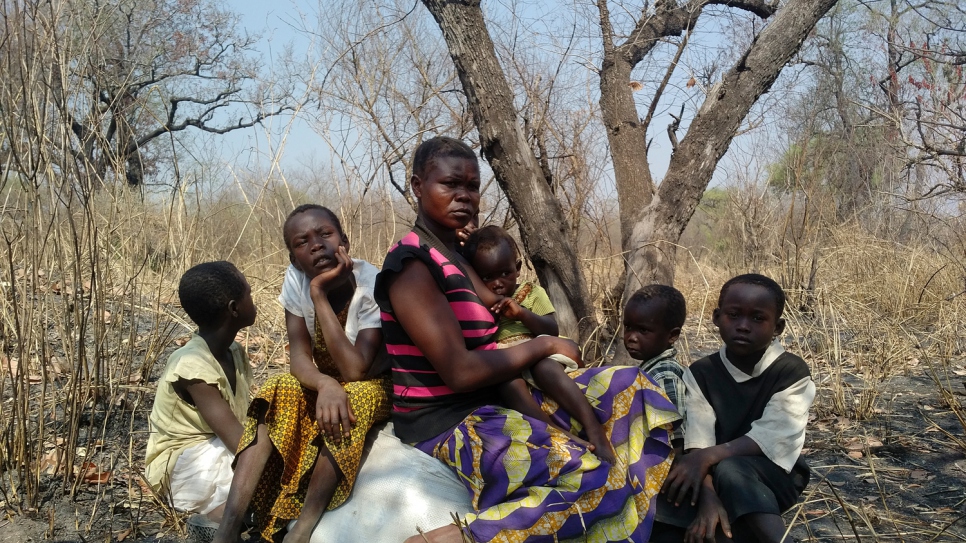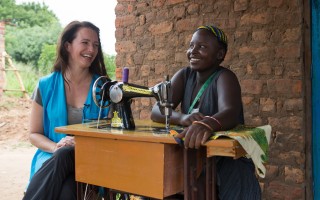
Sidah Hawa and her children fled conflict in South Sudan and reached safety in Uganda after traveling for two days. © UNHCR/Michele Sibiloni
As violence surges, South Sudanese refugee population in Uganda more than triples in six months to 698,000.
Sidah Hawa stares towards the horizon. The scorching sun filters through the sparse shade of the tree under which she sits. Her six children huddle close as she breastfeeds Asanti, her 18-month-old baby.
“I have suffered a great deal; these past few days have been really bad,” she says after a long silence. “I didn’t have enough food. I had raw cassava. This is what I fed my children. When they were tired, we rested then I gave them some water.”
Sidah, 30, recently arrived in Kuluba, a small dusty town in northern Uganda close to one of the many points along the border with South Sudan.
She is one of thousands of refugees streaming into Uganda since intense fighting broke out again in July last year following the collapse of a peace deal between the government and opposition forces.
UNHCR, the UN Refugee Agency, announced today that more than 1.5 million people have now been forced to flee the country and seek safety since conflict erupted in December 2013. This makes South Sudan Africa’s largest refugee crisis and the world’s third largest after Syria and Afghanistan – with less attention and chronic levels of underfunding.
With an extremely volatile security situation forcing more refugees to flee, the latest influx is straining the capacity of transit and reception centres, which are too small for the growing number of arrivals.
“I walked for two days to the border, but I didn’t use the main roads.”
Since January 2017, more than 52,000 refugees have been received in Uganda, with the majority crossing at border entry points such as Busia, the one Sidah and her family used, to find refuge. Many refugees are using informal entry points citing the presence of armed groups on the routes to the main border points.
Thousands more have made huge detours on foot to escape South Sudan, heading south through the Democratic Republic of the Congo, or DRC, then east into Uganda for fear of attacks from armed forces present along the direct routes. Some report walking for more than a month before finally reaching safety.
The majority of the refugees are being hosted by Uganda, where a total of some 698,000 have now arrived. In less than six months, Uganda has more than tripled its population of South Sudanese refugees, hosting the largest share of the people who have fled their homes in the neighbouring country.
Ethiopia is also hosting some 342,000, while more than 305,000 otthers are in Sudan and some 89,000 in Kenya, 68,000 in the Democratic Republic of the Congo and 4,900 in the Central African Republic.

Sidah Hawa queues with her children at Kuluba transit centre to get registered and have her children vaccinated. © UNHCR/Michele Sibiloni
Appealing for more assistance, UNHCR spokesperson William Spindler added: “More than 60 per cent of the refugees are children, many arriving with alarming levels of malnutrition… Recent new arrivals report suffering inside South Sudan with intense fighting, kidnappings, rape, fears of armed groups and threats to life, as well as acute food shortage.”
Sidah endured a three-day journey to the border from her home in Mogo in Yei County in southwestern South Sudan, which enjoyed relative stability until fighting spread to the area.
“I walked for two days to the border but I didn’t use the main roads,” she says. “We walked through the bush because if you meet soldiers they might kill you.”
“I spent six days hiding in the bush with my six children.”
Sarah Apayi is one of 6,000 refugees who used the DRC route to get into Uganda since the middle of 2016. Due to checkpoints and banditry along the main roads, more refugees are forced to use this longer route, walking several days to reach Uganda, usually with few belongings and limited access to food, water and other needs.
“My husband was kidnapped over a year ago after the war started,” Sarah says. “I spent six days hiding in the bush with my six children trying to get to DRC.” She spent another two days from Bokolo in DRC to Uganda. “It was difficult because it is not safe in the bush. I was worried about wild animals but it was better to try that way than to be attacked by the rebels.”
Like Sidah and Sarah, women and children continue to bear the brunt of the conflict, making up 86 per cent of refugees arriving in Uganda.
“This has been a massive, unrelenting emergency with close to 2,000 refugees arriving in Uganda daily,” says Nasir Fernandes, a senior emergency operations coordinator with UNHCR. “Our number one priority is saving lives and ensuring the basic needs of new arrivals are met as quickly as possible.”
To cope with the growing influx, new arrivals are first taken to a temporary reception centre in Kuluba, where refugees are registered by the government as soon as they arrive. They are provided with sleeping mats, blankets and sanitary materials, and children are immunised against measles and polio, while they await to be transferred to Palorinya settlement.
Palorinya settlement opened in December 2016 after Bidibidi settlement became full. Having been opened in August 2016, Bidibidi settlement has become one of the largest refugee-hosting areas in the world in the space of a few months. Preparations are underway to open a new settlement as Palorinya is already close to its hosting capacity.
Uganda is widely recognized as having progressive and forward-thinking refugee and asylum policies. Upon receiving refugee status, refugees are provided with small areas of land in villages integrated within the local host community; a pioneering approach that enhances social cohesion and allows both refugees and host communities to live together peacefully.
The process of receiving refugees at the border to place them in settlements takes an average of just three days. In addition, refugees are granted a range of rights and freedoms, allowing them to work, start businesses and freely move around the country.
“I am happy that I am finally safe.”
In less than six months, Uganda has more than tripled its population of South Sudanese refugees, hosting more than half of the 1.1 million people who have fled their homes in the neighbouring country.
“The Ugandan Government deserves tremendous praise in their efforts in handling the emergency,” Fernandes says. “But this crisis is not something Uganda can tackle alone. It’s now absolutely vital that the international community pay attention to what is happening and supports Uganda in providing these refugees with an environment in which they can live in safety and dignity.”
In 2016, the humanitarian appeal for the South Sudan response received less than 75 per cent of the funds needed to meet the demands. Without further contributions, the abilities of the humanitarian response to provide critical aid and key basic services could become severely compromised.
Sidah says she is grateful to have found peace in Uganda and a chance to start over.
“I am happy that I am finally safe,” she says. “I wanted the suffering to end and I now feel that it is in the process of ending.”
Donate now to help Sudanese refugeesBy Cathy Wachiaya. Post originally appeared on unhcr.org





